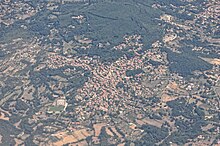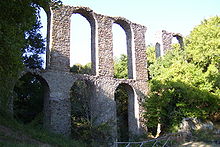Canale Monterano
| Canale Monterano | ||
|---|---|---|

|
|
|
| Country | Italy | |
| region | Lazio | |
| Metropolitan city | Rome (RM) | |
| Coordinates | 42 ° 8 ' N , 12 ° 6' E | |
| height | 378 m slm | |
| surface | 37 km² | |
| Residents | 4,198 (Dec. 31, 2019) | |
| Population density | 113 inhabitants / km² | |
| Post Code | 00060 | |
| prefix | 06 | |
| ISTAT number | 058016 | |
| Popular name | Canalesi | |
| Patron saint | St. Bartholomew | |
| Website | Canale Monterano | |
Canale Monterano is an Italian commune in the metropolitan city of Rome in the Lazio region with 4198 inhabitants (as of December 31, 2019). It is 57 km north-west of Rome and 10 km north-west of Bracciano .
geography
Canale Monterano is located in the volcanic hill country with its deeply carved valleys, west of Lake Bracciano between the Sabatine Mountains and the Tolfa Mountains . The districts of Carraiola, Casenove, Castagno, Montevirginio and Stigliano belong to the municipality.
The neighboring municipalities are Manziana , Oriolo Romano ( VT ), Tolfa and Vejano (VT).
traffic
Canale is on the SP 3A Braccianese Claudia provincial road, which leads to Rome via the SS 493. The nearest train station is in Manziana on the FR3 Rome-Viterbo regional line .
history
The Etruscans founded a settlement on a hill to the west of the modern town near today's Canale Monterano. Their necropolises are still preserved on the Palombara plateau and on the Colle della Bandita . With the conquest by the Romans, the place slowly became depopulated. In contrast, the Etruscan village in the district of Stigliano experienced a heyday thanks to its thermal springs. It got the name Aquae Apollinares . The municipality was crossed by the Via Clodia . Forum Clodii was founded on her as a street station, which developed into an important place and became a bishopric. This still lives on today as the titular bishopric Foroclodiensis . Angel Gelmi Bertocchi from Bolivia last held this title.
During the Migration Period , the inhabitants gave up Forum Clodii in the 6th century and repopulated the hill of the Etruscan town, which was easier to defend. The bishopric was moved to Sutri around the year 1000 . The town of Monterano belonged to the Orsini , who however expanded nearby Bracciano to their center. West of Monterano they founded a settlement that was named Canale because of the canal-shaped valley in which it lies . In the 17th century Monterano and Canale came into the possession of the Altieri family who, as the dukes of Monterano, set up their second residence after Oriolo here. However, since Monterano was increasingly threatened by malaria , the population center slowly shifted to Canale. After the destruction by French troops in the spring of 1799, Monterano was finally abandoned. In 1871 the area came to the Kingdom of Italy and was raised to an independent municipality with the name Canale Monterano .
Population development
| year | 1871 | 1881 | 1901 | 1921 | 1936 | 1951 | 1971 | 1991 | 2001 |
|---|---|---|---|---|---|---|---|---|---|
| Residents | 1,083 | 1,116 | 1,525 | 1,845 | 2,033 | 2,166 | 2,022 | 2,698 | 3,298 |
Source: ISTAT
politics
With the election on June 5, 2016, Alessandro Bettarelli was elected as the new mayor.
Attractions
- West of Canale in the Monterano nature reserve are the remains of the medieval town of Monterano with the impressive ruins of the church of San Bonaventura designed by Gian Lorenzo Bernini and the Orsini castle with two corner towers; the building was converted by the Santacroce family , the predecessors of the last owners, the Dukes Altieri, into a palace with a row of six-arched arcades. A lion sculpture was installed as a fountain under him in front of the rock. There is an aqueduct nearby, which was used to supply the town and castle palace.
- East of Canale in the district of Montevirginio is the Carmelite monastery, built in the 17th century, in which several late Baroque altar paintings can be seen.
- The thermal springs of Stigliano have been known and used since the Etruscan era. Today there is a thermal hotel, the construction of which dates back to the 18th century. It is surrounded by a botanical garden. Nearby are the ruins of the ancient Temple of Apollo.
Sons and daughters of the place
- Lidio Gasperini (1934–2009), researcher of the Roman history of Monterano at the Universities of Macerata and Roma 2 Tor Vergata.
literature
- Joan Marble: A Garden in Italy (= Diana-Taschenbuch 62, No. 239). Paperback first edition. Diana-Verlag et al., Munich et al. 2001, ISBN 3-453-19571-X .
Individual evidence
- ↑ Statistiche demografiche ISTAT. Monthly population statistics of the Istituto Nazionale di Statistica , as of December 31 of 2019.
Web links
- ProLoco Monterano (Italian)
- Canale Monterano on www.comuni-italiani.it (Italian)
- Terme di Stigliano (Italian)



